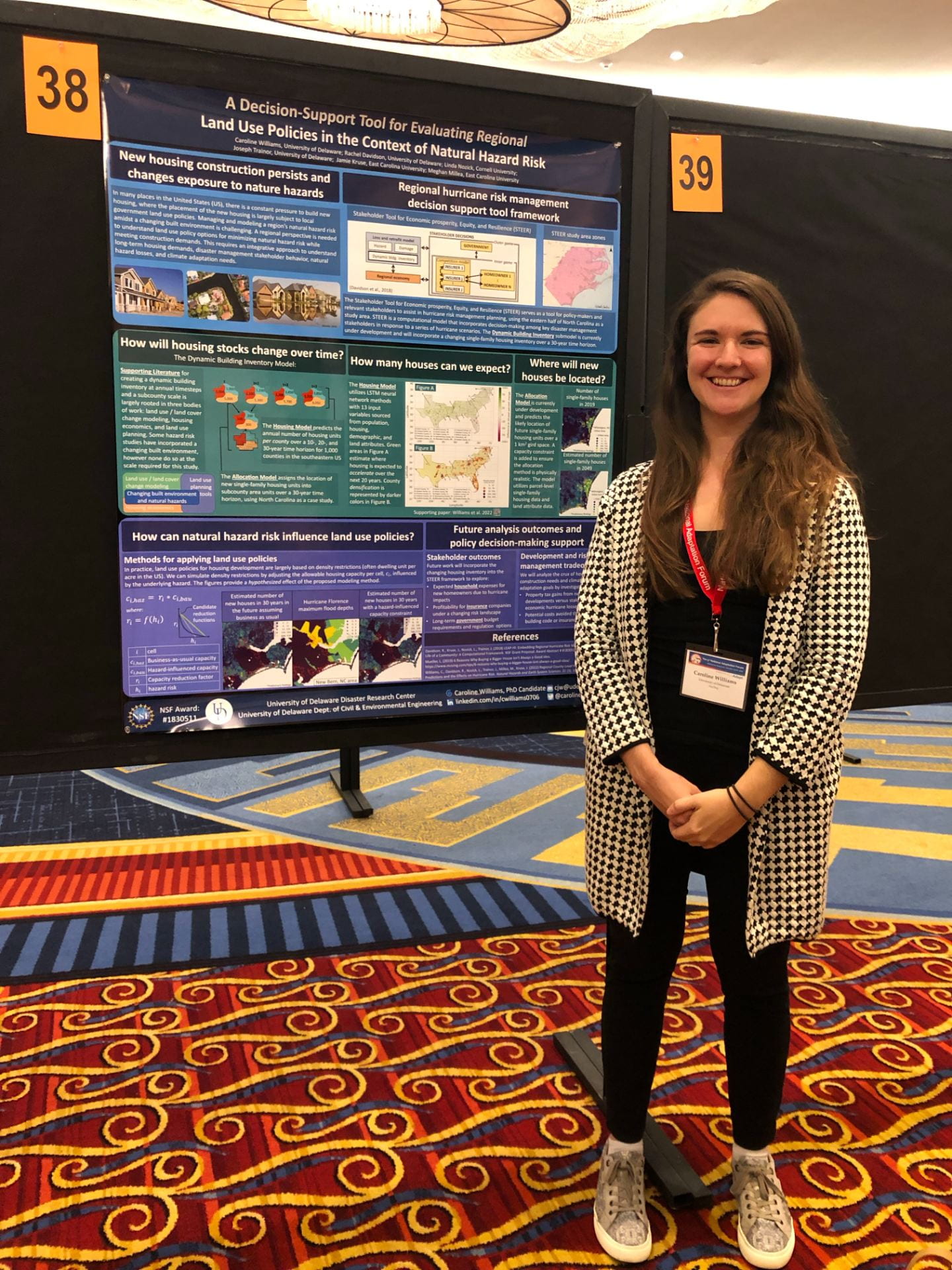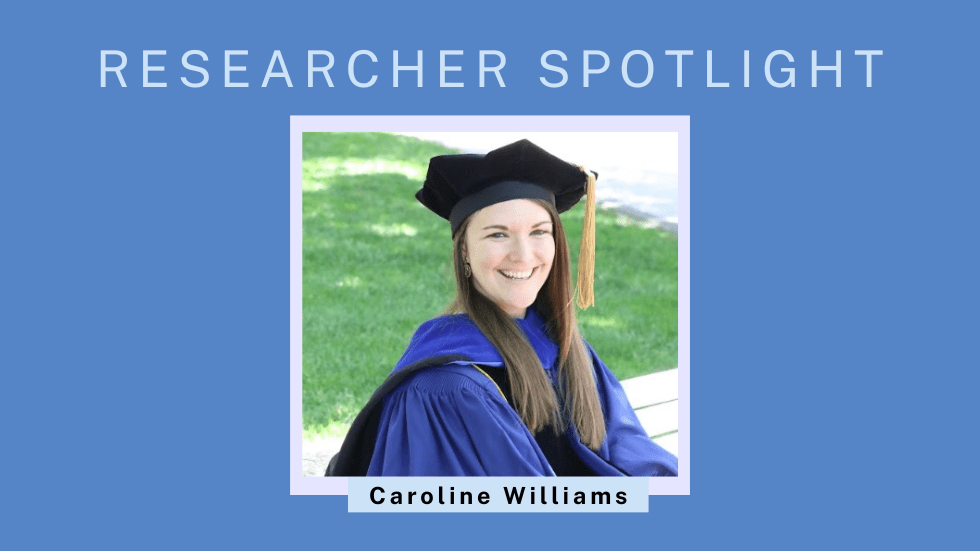Summary
Thanks to Caroline Williams, a postdoctoral researcher, CHEER's knowledge framework is well on its way to becoming a vital resource for the Hub.

Caroline Williams presents her research at the National Adaptation Forum in Baltimore, Maryland on October 26, 2022. (Photo Courtesy of Caroline Williams)
Postdoctoral Researcher – Buildings Thrust, Knowledge Framework Team
University of Delaware | Civil and Environmental Engineering
Caroline Williams is originally from Canton, Michigan, and now resides in Washington, D.C. She has a B.S. in Civil Engineering from Michigan State University and an M.Phil. in Engineering for Sustainable Development from the University of Cambridge. She graduated in 2023 from the University of Delaware with a Ph.D. in Civil Engineering with a concentration in Civil Infrastructure Systems.
Tell me a little bit about your path to becoming a part of the CHEER team. Why and how did you get involved with the Hub? How long have you been a part of the team?
I’ve been involved with the Hub since the very beginning. I was just finishing a two-year stint at a civil engineering consultancy firm in the land development industry when I was looking at Ph.D. programs in 2018. I came across the NSF LEAP-HI project – the unofficial precursor to CHEER – at the University of Delaware and was immediately interested. I had previously been involved in narrow aspects of disaster-related projects throughout my academic career, but I was looking to be a part of disaster research that incorporated multidisciplinary perspectives. LEAP-HI allowed me to do just that. This project models the impacts of hurricanes in a changing built environment alongside real-world stakeholder decision-making.
It sounds like LEAP-HI and CHEER kept you very busy throughout your doctoral program. Have there been any research experiences or projects that you have found particularly memorable or enjoyable?
As a Ph.D. student at UD, my main project was developing a modeling method to predict where new single-family housing units would likely be built over a 30-year projection period under different land use policy scenarios in the eastern half of North Carolina (Williams et al. 2022; Williams et al. 2023).
I also worked on several side projects during my doctoral studies that directly relate to my work in the Hub. One of those projects, which was published in the Journal of Structural Engineering, was a computational analysis of complex (non-rectangular) roof shapes (Meng et al. 2023). I also worked with a team at SimCenter, a CHEER Hub partner, to assess data and simulation needs for disaster recovery research (Zsarnóczay et al. 2023). That study was published in Natural Hazards Review.
What is your role in CHEER? Has your research in the Hub changed over time?
I am a postdoctoral researcher on the buildings thrust team, and I also work on the knowledge framework team. Both of these areas build upon my earlier research as a Ph.D. student. On the buildings team, I work with other team members to think about how the representation of buildings and people will be integrated into the main computational framework over time and space. I’m currently working on an analysis that compares hurricane loss outcomes under different combinations of land use and building code policies.
I’m also involved in the preliminary development of the CHEER Knowledge Framework (CHEER/kf*) with Chris Lenhardt, the Knowledge Management Director, and Mohammad Askari, a Ph.D. candidate at UCLA. In a nutshell, we’re creating a system that helps conceptualize, maintain, and share knowledge in the Hub. Much of the work is developing processes for documenting the technicalities of the computational models developed on our team while also providing guidance for the integration of each team member’s contributions to the CHEER project.
The CHEER/kf* seems to be a vital but behind-the-scenes facet of CHEER research. Can you tell me a little bit about why it’s so important and its purpose in the Hub?
The Hub has a lot of moving parts. There are more than 40 researchers and students stretched across six thrusts. With such a large, multidisciplinary team, it’s imperative that we have an overarching yet consistent approach for sharing knowledge internally among team members and externally with the wider community. Broadly speaking, the purpose of the CHEER/kf* is to efficiently organize CHEER knowledge so that our thrusts can operate with ease and research impact can be maximized.
How will the CHEER/kf* be used by CHEER?
The CHEER/kf* has two parts: it is both a concept and a practical resource for the Hub.
As a concept, the CHEER/kf* is a cultural understanding that data and knowledge must be thoughtfully and collaboratively organized and shared in a team environment to support transformative research outputs. The CHEER/kf* helps organize both team work (e.g., scheduling meetings, communicating progress) and task work (e.g., developing surveys, models, papers). In other words, the CHEER/kf* is an approach that will help thrusts collaborate and share research successfully.
As a practical resource, the CHEER/kf* provides guides for integrating, documenting, and publishing data and other research artifacts so that they are usable for a variety of audiences. The CHEER/kf* team has recently received a Research Allocation at DesignSafe to store our data and access high-performance computing resources and has also created a CHEER GitHub page to manage code. These processes and guides are currently under development, and we will soon seek input from the larger CHEER team.
You will soon be starting a new chapter in your career. What will you be doing? How has your time in the Hub prepared you for your next steps?
I have been selected as a fellow through the American Association for the Advancement of Science’s Science and Technology Policy Fellowship. The fellowship links scientists and engineers with federal government positions to support science and technology policy. Through the fellowship, I accepted a job offer at the U.S. Department of State in the Office of Australia, New Zealand, and Pacific Islands Affairs and am now waiting for the approval of my security clearance. My time in the Hub has equipped me with the skills I will need to succeed as I start this new chapter.
I feel incredibly grateful to have worked on this multidisciplinary team over the past four years because it has allowed me to strengthen my science communication skills in translating technical topics to non-technical audiences. I believe this, along with my broad knowledge of data science, machine learning, and risk analysis, will launch me into a fruitful career in tackling challenging policy problems in the natural hazard risk, climate change, and/or housing space moving forward.


